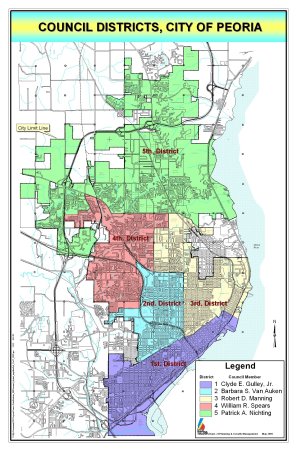There has been no small amount of discussion about handicapped parking lately. Bill Dennis has had several posts on it. And it even came up in the City Council meeting Tuesday night (the last one of the year). Bill called it “the tyranny of good intentions,” and that’s a good name for it. I’m not at all bothered by handicapped spaces at these new developments with their huge swaths of land dedicated to parking. It doesn’t bother me to walk a little farther — probably because I grew up with a father who was overprotective of his car and we always parked a mile away from everyone else anyway.
But the trouble with this “one size fits all” rule (as Gary Sandberg calls it) comes when you try to apply it to neighborhood businesses in the older part of town — businesses that already have severely limited parking. Gary explained at the council meeting that if one of these places only has four parking spaces, and then you require them to have one space dedicated to handicapped parking, then you leave them with only two non-handicapped spaces and one handicapped space (double-wide by definition) that will go unused a majority of the time. And then, the building is probably not handicapped-accessible anyway, so you’ve just made them make the parking lot accessible for nothing. In the attempt to make things more accessible, you’ve actually made it less accessible overall.
But parking isn’t the only place where that’s happening. The FCC has mandated that all new programming must be closed captioned starting January 1, 2006. There are a few exceptions (parades, high school games, “non-news programming with no repeat value”), but most programs will have to be closed captioned starting in a couple of weeks.
Now, I’m all for closed captioning. But the problem is that it’s expensive. The first thing you have to do is transcribe your program. You can do it yourself (labor-intensive) or hire a professional stenographer (or “stenocaptioner”) at $1.50 to $3 per minute, or $90-$180 per one-hour show. Then you have to get it into the video stream using an encoder. Encoder services can run you $300-$400 per one-hour show. Alternatively, you could buy encoding equipment and do it yourself, but then you have your own labor costs, plus equipment that can cost as much as $20,000. Your closed-captioning cost is now almost as much as the fee you’re charged to broadcast the program on a local TV station. So what do you think smaller operations are going to do? Stop broadcasting their programs, of course. Or at least remove them from some smaller markets, like one show in New York is doing.
Thus, once again, in an attempt to make things more accessible, they’ve made them less accessible. In the case of some smaller operations, in the FCC’s effort to make programs accessible to all, they’re making them accessible to none. The tyranny of good intentions, indeed.
(I realize blogging about work is a no-no in the blogosphere, but just so there’s no misunderstanding or errant reading between the lines, let me just say briefly that Grace’s program is staying on the air and will be captioned.)


